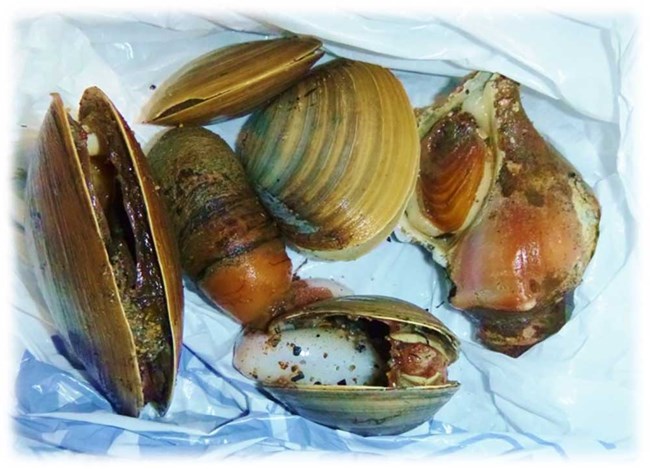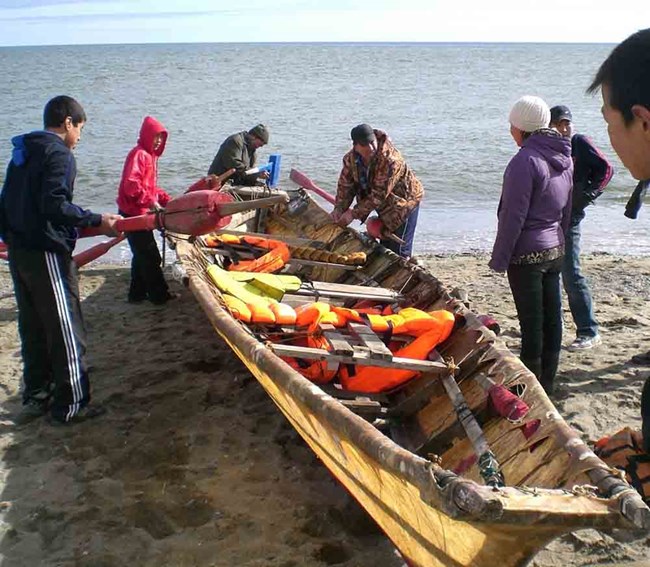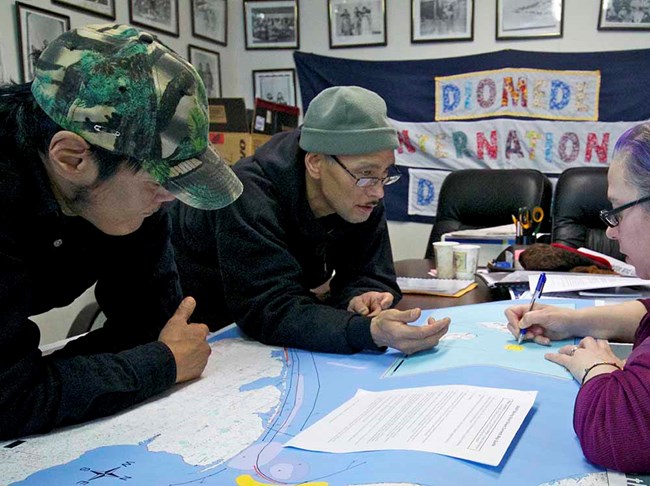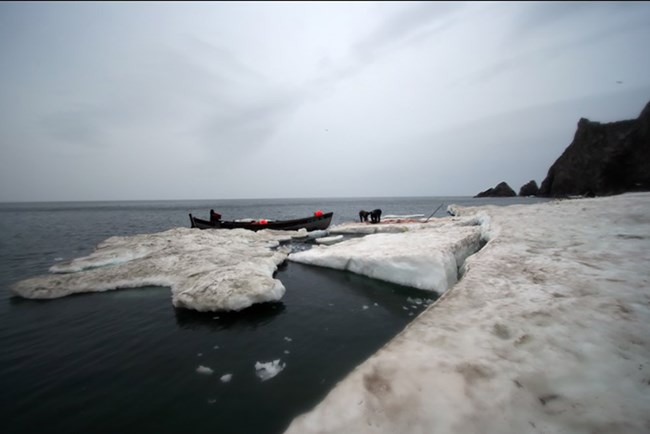Part of a series of articles titled Alaska Park Science - Volume 20, Issue 2. Beringia: A Shared Heritage.
Article
Ocean Currents and Food Security: The Crucial Role of Bering Strait Traditional Knowledge
Anastasia Yarzutkina, Ammosov North-Eastern Federal University (Russia)

Kawerak, Inc/Julie Raymond-Yakoubian
The Elders told me about currents, and also showed them to me from the boat. I learned more by example. I have been on the water since childhood and I learned everything from observation.
–Evgeny Siv-Siv, Inchoun, Chukotka, Russia
Learning these things young will feed you and your family for the rest of your life.
–Gilbert Oxereok, Wales, Alaska, USA
There are numerous ocean currents operating in the Bering Strait region (the area including the Strait itself, as well as the northern Bering and southern Chukchi Seas adjacent to it). Some currents flow for long distances, some are small and more localized, like eddies. Other currents are impacted by the tides, either temporarily switching direction (e.g., at channels leading into inlets), or changing their speed (e.g., becoming slower or “weaker” at high tide). Seasonal currents appear only during certain times of the year and under certain environmental conditions. Currents can also dramatically decrease in speed of flow, and even reverse or temporarily stop flowing, under the right conditions. The ability to identify and read the behavior of currents in the Bering Strait is something residents of the region have depended on for millennia.
The Importance of Ocean Currents Knowledge
Knowledge of ocean currents is critical to the food security of Indigenous Peoples of the Bering Strait. Ocean currents knowledge is intimately tied to individuals’ and communities’ knowledge and understanding of animal behavior and migrations, sea ice movements, the best and safest times to travel on the ocean, navigation, weather prediction, and much more. This information is a crucial part of a larger system of knowledge that Indigenous communities hold known as Traditional Knowledge (Kawerak Social Science Program 2017). The depth and complexity of an experienced hunter’s knowledge is virtually impossible to describe. Hunters, boat captains, and other marine experts have learned about currents through direct experience on the water, by watching more experienced people when they are out on the water, and through direct instruction from Elders and others. This includes learning how to describe ocean currents and their behavior in Indigenous languages, which is often is more expedient and more richly detailed than describing them in English. The following table has some examples of Iñupiaq terms related to ocean currents.
| Iñupiaq Term | English Translation |
|---|---|
| saġvaq | Ocean or river current |
| asaanaałuk | Very fast current going outward at the channel |
| asaanaaq | Slow current going outward at the channel |
| ayaktaq | Person that floats away on ice, boat, etc. |
| itiqsaanaaq | Slow current going into/toward the channel |
| itiqsaanałuk | Very fast current going into/inward at the channel |
| saġvaatuzruaq samna | That one out there that has a very strong current (referring to the strongest current running north between Wales and Pt. Hope) |
| tuluqtitaq (sing.) tuluqtitat (pl.) | Ice pushed over shore ice or on to the beach by a strong current/wind |

Brenden Raymond-Yakoubian
Food security has many components, including access to healthy, culturally appropriate foods. For Bering Strait Indigenous communities, this includes the means and ability to harvest marine and other foods, as they have done for millennia. Food security as defined by ICC Alaska (2020) includes:
... the right of all Inuit to define their own hunting, gathering, fishing, land, and water policies; the right to define what is sustainably, socially, economically, and culturally appropriate for the distribution of food and to maintain ecological health; and the right to obtain and maintain practices that ensure access to tools needed to obtain, process, store, and consume traditional foods. Within the Inuit food security conceptual framework, food sovereignty is a necessity to support and maintain the six dimensions of food security.
Hunters and others traveling on the ocean must be able to quickly and accurately interpret the interactions of wind, ice, and currents and anticipate the behavior of both marine animals and humans in order to maintain safety and to successfully harvest animals (Kawerak, Inc 2013). Successful harvests are crucial to the food security of communities, to individual and community well-being, for intergenerational knowledge sharing, the continuation of spiritual practices, and for other important aspects of contemporary Indigenous lifeways (e.g., Gadamus and Raymond-Yakoubian 2015, B. Raymond-Yakoubian et al. 2014, J. Raymond-Yakoubian et al. 2014, ICC Alaska 2020).

Chukot Tinro
Ocean currents knowledge is critical for communities to maintain unique and living bodies of Traditional Knowledge and distinctive subsistence practices. Some Indigenous ocean currents experts have concerns about the contemporary challenges of passing on this body of knowledge and experience to younger generations, a lack of Indigenous language skills related to the marine environment, and the safety of young boaters and boat captains. Some see an over-reliance on GPS and satellite technology as a detriment to learning from traditional knowledge. In order to stay safe and be successful, younger generations must continue to learn and older generations must continue to teach.
Being a boat captain in an Indigenous community is a substantial responsibility. Captains are boat owners who train and work with skilled hunters as their crew. These crews, under the direction of the Captain, hunt for marine mammals such as whales, walruses, and seals, obtaining large amounts of food for their communities. Without successful hunts, the food security of a whole community may be at risk. Captains have the safety of their crews, as well as the welfare of their communities, weighing on them. If they make an error, other crews may have to risk their lives to rescue them. If they are not successful finding animals, the community may not have enough food. Additionally, gasoline and motor oil are very expensive in all Bering Strait region communities (gasoline may be $5 a gallon or more). Hunters must have the knowledge needed to calculate their fuel needs, including knowing how much more fuel is used when traveling against currents or strong winds or in rough seas. Miscalculations can lead to crews becoming stranded. Good boat captains recognize all of these factors and use their knowledge to understand weather and ice conditions, the effects of climate changes, crewmember skills and abilities, and other factors that must be considered before heading out on to the water.

Meghan Sigvanna Topkok
He’s the captain, that’s his boat. He’s the person that is very responsible. He’s making sure that no one forgets anything. He’s a big man there. He’s the man that takes care of everything; food, animal, whatever you need, make sure you are dressed properly and what not. He knows the weather. He knows the current. He knows everything. Even in conditions where it gets so bad when we are hunting. He’s got to know this stuff, he got to know what to do, what to expect and what not to expect.
–Robert Soolook, Diomede, Alaska, USA
And then, first of all, we try to look for where we think the game is. … we estimate how long it will take from where we see it, then get ready, and how long we think it will drift – head to that spot. … And then at the same time you’re doing that, you as a captain have to try to calculate how much gas to carry to reach that area, and come back. Course you’re gonna be fighting against the current, you must figure that part out, too. It’s a serious calculation. You have to be serious about it. And then you have to communicate with other captains that are going out there, too. Communication is very important.
–Luther Komonaseak, Wales, Alaska, USA
Marine Animals and Ocean Currents
Just like humans, marine mammals and other animals use ocean currents for a variety of purposes. One of the primary reasons animals spend time near ocean currents is because the currents are a source of food. Marine mammals, birds, and fish use ocean currents and currents bring other important resources, like driftwood and clams, to Bering Strait communities.
Importantly, the currents are also one of the things that influence sea ice movement. Ice-associated mammals such as walruses and ringed, bearded, spotted, and ribbon seals, use the ice and the currents. These animals pup, calve, mate, and rest on ice and use ice as a platform to escape predators. When using the ice for these purposes, the animals are moved along with the currents.
Hunters know that if animals cannot be found near the ice edge that they are probably out in the current. There are some areas, such as eddies and leads, places where there will be open water maintained by the current, where hunters will also look to find animals. Additionally, hunters have such detailed knowledge of currents that they can often predict where a struck and lost animal may drift to or come ashore and are then able to recover it.
That was one story my dad told me one time. … he said even if you can’t find walrus or anything out here, always check out this … big eddy in there [pointing to the map]. … So we found walrus there one time.
–Curtis Nayokpuk, Shishmaref, Alaska, USA
We have always used currents when harvesting marine mammals. Old people would go from Nunyamo towards Yandagay. They would go out to sea, search for walruses on ice, kill them, and while they butchered them, they would drift with the current back to the village. Now they no longer use this trick – there are few walruses, and we have motors.
–Evgeny Einycheivun, Lavrentia, Chukotka, Russia
Pollution Also Moves on Ocean Currents
Trash, while not a desired resource, is something else that ocean currents bring to the Bering Strait shoreline. Like any other form of pollution, trash is a concern for communities because of the potential impacts it could have on subsistence resources like marine mammals, birds, and fish. People are concerned about past and future increases in vessel traffic through the Bering Strait and the possibility of trash and dangerous materials, such as an oil spill, being transported to their communities by ocean currents. The summer of 2020 unfortunately brought a large marine debris event to the region’s Alaskan shores (Kawerak, Inc 2020).
Safety
Safety is a major concern when traveling on the ocean and expert hunters shared information about how to stay safe. No one should ever underestimate the power of the environment, especially the currents. Ocean currents are perceived by some as being one of the more consistent features of the marine environment. But, the ice and the currents cannot be separated from each other. One Diomede Elder, Arthur Ahkinga, Jr., explained that: the currents, they operate the ice.

Andrei Stepanov
A warming climate has led to thinner ice that behaves differently than thicker, older ice. For example, the ice in front of the village of Diomede (on the west side of Little Diomede Island) would often freeze flat in the past. These conditions allow easier access to hunt by foot on the ice and easier transport of boats to the ice edge for hunting. Today, while the ice initially freezes flat, it is often “crumbled up” and piled by the currents and the winds because it is thinner and can be pushed around more easily. The force of currents and winds pushing on thin ice pans causes them to pile, ice pan upon ice pan, creating jumbled, “crumbled” ice. This can be very dangerous, particularly on the south side of the island (see also Iyahuk 1987).
Driftwood and other floating debris can create hazards and boaters should always be scanning to identify and avoid debris. At certain times of the year, there can be large amounts of driftwood and debris transported by the currents. This debris can damage or destroy outboard motors or cause damage to boats.
When on the ice hunting or butchering an animal, it is important to move quickly. Weather conditions can change unexpectedly and the current is always moving. Hunters should identify a “marker” when hunting on the ice, such as finding a landmark, like a building or mountain and memorizing its location. If the marker has moved, the ice you are on is moving and may not be safe.
In addition to monitoring landscape features and other environmental indicators, marine current experts observe the currents themselves to try and predict impending weather conditions. If signs indicate changing or bad weather, one should head to safety immediately (see also Okpowruk 1983). It is also important to have an Elder or a very experienced person in the boat whenever possible to ensure that someone on the boat has the knowledge or experience to deal with any situation that a crew may encounter (see also Jones 2003). While the safety and success of the crew is ultimately the responsibility of the boat captain, all the crew members on the boat are expected to have knowledge of the ocean currents, navigation landmarks, and other relevant information.
We used currents during marine mammal harvest to determine whether it was safe to walk on ice, or to tow harvested animals without the risk of being carried off by the sea. The current may carry you off if you disregard it, especially in the old days when we had no motors. When we sailed we headed half way into the current to make up for the drift. I don’t know [whether currents were used] for harvesting other resources. They were not used for travel, only for hunting … and also for weather forecasting. If a current flows that way – the weather will change. If a current flows south, then it will blow from the north, so the weather will change. We watch the current, the wind and the mountains – all together they give us the weather forecast.
–Nicolay Ettitegin, Lavrentia, Chukotka, Russia
Conclusion
There are many ongoing challenges for Bering Strait communities related to Indigenous food security and the marine environment including climate changes, sea ice loss, and increasing vessel traffic. The deep understanding of how and where currents operate, which resources they may bring during different seasons, and how to safely navigate currents and use them to your advantage supports other knowledge that hunters and communities collectively maintain and utilize as part of their food security (e.g., Kawerak, Inc. 2016). This living body of knowledge, including the cultural values embedded within it, provides strength and flexibility to communities as they work to successfully lead the way through challenges.
Acknowledgements and Contributors
For the Beringia Shared Heritage Program-funded project Indigenous Knowledge and Use of Ocean Currents in the Bering Strait Region, Kawerak collaborated with the Native Villages of Wales, Diomede, and Shishmaref, the Chukotka Branch of Pacific Scientific Research Fisheries Center, and Indigenous residents Inchoun, Lorino, Lavrentia, and Neshkan. The project documented knowledge related to ocean currents and their uses, their physical characteristics, Indigenous terminology of currents, spatial information about currents, and other related information. The project promoted the sharing, preservation, and exchange of knowledge within and between communities, and made this knowledge available for other purposes, such as marine planning. Interviews with community-identified experts, community meetings, and mapping were all carried out, in both Alaska and Russia. These collaborations resulted in a detailed final report (Raymond-Yakoubian et al. 2014), an educational booklet (Kawerak Social Science Program 2014a), and the creation of an English/Russian language poster (Kawerak Social Science Program 2014b). The report includes a glossary of Iñupiaq terms and phrases related to currents, a visual guide to hand signals that hunters use while out in the ocean, and a map of ocean currents and other marine features. The information in this article is derived from those project products.
The experts who collaborated on this project shared the sophisticated decision-making calculus that they engage in each time they contemplate taking their boats on to the ocean to hunt, travel, or for other activities. Their understandings of a complex ecosystem, and a changing ecosystem, along with other community-held knowledge, has allowed communities to thrive for millennia in the Bering Strait region.
The following ocean currents experts in Alaska contributed their time and knowledge to this work. In Shishmaref: Francis Kakoona, Morris Kiyutelluk, Curtis Nayokpuk, Harvey Pootoogooluk, John Sinnok, Davis Sockpick, Clarence Tocktoo, and Vincent Tocktoo, Sr.; in Wales: Michael Ahkinga, Sr., Luther Komonaseak, Gilbert Oxereok, Raymond Seetook, Sr. and Winton Weyapuk, Jr.; and in Diomede: Arthur Ahkinga, Orville Ahkinga, Sr., John Ahkvaluk, Jerry Iyapana, Patrick Omiak, Sr., Edward Soolook and Robert Soolook, Jr. Kawerak, Inc. led the Alaska collaborations.
Project staff in each community greatly contributed to these collaborations. This includes Lucy Iyatunguk and Edwin Weyiouanna in Shishmaref, Gene Angnaboogok in Wales, and Robert Soolook, Jr. in Diomede. Kawerak staff Maggie Kowchee transcribed interviews, and Helen Pootoogooluk transcribed interviews and conducted archival research. Obie Simonis created the ocean currents map in the final report. Meghan Sigvanna Topkok, Social Science Program Intern, worked on many components of the project. John Sinnok of Shishmaref and Winton Weyapuk, Jr. of Wales also greatly assisted the project by reviewing and correcting the Iñupiaq words and phrases.
In Chukotka, experts in the following com-munities also contributed their knowledge and time to the project. Inchoun: Arthur Nuteveket, Sergey Pucheneut, Evgeny Siv-Siv; in Lavrentia: Oleg Dobriev, Evgeny Einycheivun, Vladimir Einycheivun, Nicolay Ettitegin, German Gheukay, Igor Zdor; in Lorino: Nicolay Aratyrgin, Yakov Etton, Andrei Ettuvye, Gennady Inankuyaz, Anatoly Napayuk, Alexey Ottoy, Vladimir Piny, Eduard Ryphrghin; and in Neshkan: Nikolai Ettyne and Eduard Zdor. Yury Khokhlov and Anastasiya Yarzutkina with the Chukotka Branch of Pacific Scientific Research Fisheries Center (ChukotTINRO) in Anadyr, Chukotka, Russia led the Chukotka collaborations, along with Dennis Litovka.
Kawerak also thanks Seth Danielson of the University of Alaska Fairbanks, Institute of Marine Science, and Rebecca Woodgate of the University of Washington, Applied Physics Laboratory; Raymond Seetook, Sr., Debra Seetook, Rueben Oxereok and Jessie Ongtowasruk of Wales; Curtis Nayokpuk, Vincent Tocktoo, Sr., John Sinnok, and Johnny Pootoogooluk of Shishmaref; Fred Tocktoo of the National Park Service; Guy Martin of the National Park Service Shared Beringian Heritage Program, for their participation in an ocean currents workshop associated with this project (Raymond-Yakoubian et al. 2014: 52-56).
References
Gadamus, L. and J. Raymond-Yakoubian. 2015.
A Bering Strait indigenous framework for resource management: Respectful seal and walrus hunting. Arctic Anthropology 52(2):87-101.
Inuit Circumpolar Council Alaska (ICC Alaska). 2020.
Food Sovereignty and self-governance: Inuit role in managing Arctic Marine Resources. ICC Alaska, Anchorage, AK.
Iyahuk, A. 1987.
Interview. Kawerak Eskimo Heritage Program Archives, EC87.012. Nome, AK.
Jones, S. (editor) 2003.
Eskimo Drawings. Anchorage Museum of History and Art. Anchorage, AK.
Kawerak, Inc. 2020.
Foreign marine debris found in the Bering Sea. Kawerak, Inc.: Nome, AK. Available at: https://kawerak.org/foreign-marine-debris-found-in-the-bering-sea/ (accessed November 16, 2021)
Kawerak, Inc. 2017.
Kawerak knowledge and subsistence-related terms. Internal White paper. Kawerak, Inc.: Nome, AK. Available at: https://kawerak.org/wp-content/uploads/2018/04/Kawerak-Knowledge-and-Subsistence-Related-Terms.pdf (accessed November 16, 2021)
Kawerak, Inc, 2016.
Bering Strait Voices: Vision for Action Summit Report. Kawerak Marine Program, Nome, AK.
Kawerak, Inc. 2014a.
Indigenous Knowledge and Use of Ocean Currents in the Bering Strait Region. Educational booklet. Kawerak Social Science Program: Nome, AK. Available at: https://kawerak.org/wp-content/uploads/2018/04/OceanCurrents-book-for-web.pdf (accessed November 16, 2021)
Kawerak, Inc. 2014b.
Indigenous Knowledge and Use of Ocean Currents in the Bering Strait Region. Educational poster in English and Russian. Kawerak Social Science Program: Nome, AK. Available at: https://kawerak.org/wp-content/uploads/2018/04/Indigenous-Knowledge-and-Use-of-Ocean-Currents-poster.pdf (accessed November 16, 2021)
Kawerak, Inc. 2013.
Seal and Walrus Hunting Safety Traditional Knowledge from Kawerak’s Ice Seal and Walrus Project. Kawerak Social Science Program: Nome, AK. Available at: https://kawerak.org/wp-content/uploads/2018/04/Kawerak-Safety-Book.pdf (accessed November 16, 2021)
Okpowruk, C. 1983.
Interview. Kawerak Eskimo Heritage Program Archives. 1983.003.034 SHH. Nome, AK.
Raymond-Yakoubian, B., L. Kaplan, M. Topkok, and J. Raymond-Yakoubian. 2014.
The World has Changed: Iŋalit Traditional Knowledge of Walrus in the Bering Strait. North Pacific Research Board Project 1013 Final Report. Kawerak, Inc. Social Science Program. Nome, AK. Available at: https://kawerak.org/wp-content/uploads/2018/04/The-world-has-changed_web.pdf (accessed November 16, 2021)
Raymond-Yakoubian, J., Y. Khokhlov and A. Yarzutkina. 2014.
Indigenous Knowledge and Use of Ocean Currents in the Bering Strait Region. Report to the National Park Service, Shared Beringian Heritage Program for Cooperative Agreement H99111100026. Kawerak, Inc., Social Science Program: Nome, AK. Available at: https://kawerak.org/wp-content/uploads/2018/04/OC-report-for-web.pdf (accessed November 16, 2021)
Last updated: December 15, 2021
